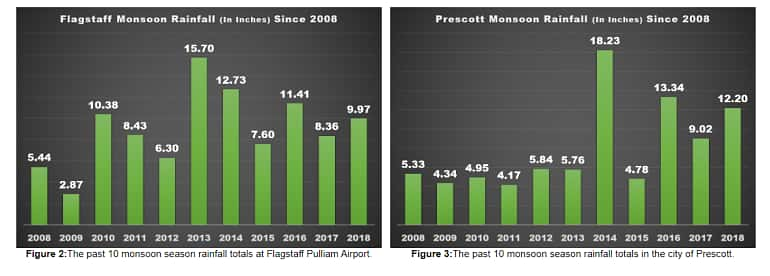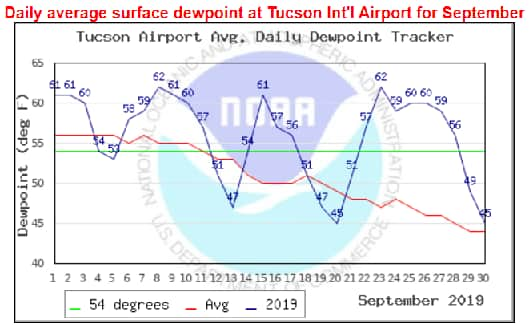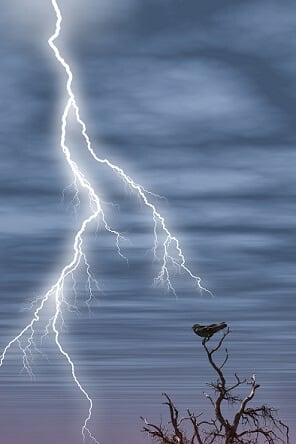The Arizona Monsoon Season is something many who live in Arizona look forward to. Say the word “Monsoon” and people usually think of Southeast Asia… Torrential rains for days and days. Jungles, flooding, mud up to the knees, mosquitoes attacking, no sun to be seen, rivers overflowing!

Well… meet Arizona’s Monsoon season!
- When Is Arizona Monsoon Season?>
- Predicting The Monsoon Season>
- What Exactly Is the Arizona Monsoon?>
- Safety In the Monsoon Season>
- Tucson Monsoon>
- Phoenix Monsoon>
- Tombstone Monsoon>
- Flagstaff Monsoon>

Monsoon Season in Arizona
The weather can be intense! With action-packed storms including vivid lightning shows and thunder from all directions. Rain may be so forceful, it feels like you’re in a tempest!
Personally we love this time of year! We love watching the thunderstorms, when possible, while sheltered under a patio roof. Lightning bolts provide an amazing light show. Entire storms can be eye-popping. Since Monsoon thunderstorms tend to be recurrent throughout the afternoon, you’ll see the sun peeking through. Wonderful color variations form in clouds. The ideal circumstances for a rainbow! Sometimes even doubling! A beautiful sight!
Abounding shades of gray, dark blue, black, against the vibrant blue sky peeking through! Shards of sunlight gleaming through slits in the clouds. Rain pouring down over there. Again way over there, then on top of you! It’s just a wonderful Weather Experience. Have your camera ready!
During the Arizona Monsoon Season, there won’t be storms every day in Tombstone Arizona. Keep in mind, precipitation totals are just Under 14 Inches in the area. That is the Cochise County yearly average! That’s enough to support the natural flora: the Chihuahuan Desert plants that live here.
Some areas of Arizona tend to get more rain during the Monsoon Season than do other areas. Here’s data on Arizona monsoon season localized areas:
Southern Arizona Monsoon Season
The Walnut Gulch Experimental Watershed records rainfall during the Arizona Monsoon Season. 59 rain gauges are across this watershed, less than one mile distant from each other. Some of that watershed is quite nearby to Tombstone Arizona.
Research published in 2019 found that beginning with the 1970s, monsoon rainfall in that area intensified. That is, comparing the same time-frame for rainfall, the rain amounts increased by 6 – 11% than in previous years.5

The I-10 Corridor en-route from Willcox to Bowie (about one hour Northeast of Tombstone) and then on to San Simon Arizona is a prime spot for dust storms. One analysis covering all Arizona from 2000 to 2011 determined that July had the highest incidents of dust storm traffic episodes. So, that’s during Arizona Monsoon Season. (April was 2nd highest because of Spring Winds.)

Here’s a dramatic video of a dust storm in the Willcox area:
Tucson Arizona Monsoon Season
What are Tucson’s monsoon season rainfall statistics from 1895 to 2019? The poorest monsoon totals occurred in 1924, with just 1.59″ of rain. The largest monsoon rainfall year was 1964, when totals were 13.84″. The average for all those years is just over 6″ of rain.7
And the average start date in Tucson for the Monsoon Season within the years 1895-2019 is July 3rd. Also the date with the most monsoon starts: nine.7
For Tucson, statistics from 1895 to 2019 show:7
- Between June 15 to June 30:
- The average number of monsoon starts was 1.63 times
- The monsoon began 26 times
- Compare between July 1 to July 15:
- The average number of monsoon starts was 2.73 times
- The monsoon began 45 times
- The earliest date the monsoon began was June 17, that was in the year 2000
- The latest date the monsoon began was July 25, that was in 1987
- The median date for the start of the monsoon, considering the dates from June 15 to July 25 is July 3rd! Seems like a significant Arizona Monsoon Season start date, don’t you think?
Take a look at this Tucson Arizona monsoon footage captured on film. Quite amazing!
Monsoon Season in Phoenix Arizona
The Arizona Monsoon Season in the Phoenix area can be quite variable. For instance, statistics compiled at one weather station, from 1896 through 2014 show a wide range of rainfall during the season. The rainiest Monsoon Season was 1984. While the least rainfall was in 1924, only a scant 0.35 inches!4
Something seen in the Phoenix area more often than elsewhere, is dust storms. They may come in advance of approaching thunderstorms. A huge bank of dust traveling across flats and desert areas of the city. Very intimidating in appearance. Recently, they’re using the Arabic word for them: haboob.6
If you see one coming toward you, Know These Safety Tips>
Northern Arizona Monsoon Season
Distinct Arizona areas generally experience the same Monsoon Season differently.
For instance, the National Weather Service points out the difference in two nearby towns: “during the 2013 monsoon season, Flagstaff recorded well above normal monsoon season total precipitation, while Prescott was almost two inches below normal.”3 Prescott’s elevation is a little over 1500′ lower, which means higher average temperatures. But thunderstorms that occur in monsoon season are quite disseminated,3 subject to very local weather affecting conditions.

Monsoon rainstorms are often a relief for the Northern Arizona fire season. The Northern forests experience the driest time of the year in the spring. By the end of June, the danger is often high, the landscape parched.3 Thus with monsoon season, plant-life is yearning for rains to come. Most people and ranchers are too!
When is Arizona Monsoon Season?
The National Weather Service expressed that the Monsoon Season in Arizona begins every year on June 15 and ends on September 30. They began those official dates starting in 2008.3
Prior to that, they adhered to dewpoint criteria. That there must be a minimum dewpoint of 55 degrees for three days in a row. Then Arizona Monsoon Season, with thunderstorm capability, had begun.

And what is the Dewpoint? That’s the temperature where water that’s evaporated into the air (that is, water vapor) begins to change into liquid water. In other words, becomes dew droplets. Which you’ll observe on windows, plants, objects in your yard, etc. It’s really more accurate than humidity for how uncomfortable you’ll feel, because of combining temperature with air moisture.1
Really, though, (from our own experience, and every other Arizonan we know!) it starts at the very end of June. Most often though, and traditionally, the Monsoon Season in Arizona starts on the Fourth of July. And often extends into about September’s end.
But go ahead and compare the general trending of the dewpoint for 2019, as an example:



What is the Arizona Monsoon Season?
The word monsoon in “climateese” refers to a wind pattern shift. The word monsoon’s origin is based on Arabic mausim which means season. This shift materializes on a regular, seasonal basis. Warmer areas over tropical waters stimulate evaporation. This evaporated moisture is carried by this wind change. When the saturated air vapor reaches hot weather areas, rain storms are generated.2
Here in Arizona it means primary prevailing winds no longer come from the West/Northwestern Pacific coast. Now they switch to a Southerly flow. Upper level winds pick up lots of tropical moisture. Combine that with summer heat. Resulting in fantastic, sky-opening thunderstorms!
That happens most often toward mid to late afternoon. But they can arise at any time, day or night. Watch clouds build as air heats up during the day. Sometimes air really becomes saturated. Then storms can become intermittent all day and evening.
Early on there had even been doubt that the Southwest U.S. really experienced a Monsoon Season. Finally scientific analysis produced findings in 1990 and 1993. Called the South West Arizona Monsoon Project, it found there indeed was a seasonal wind shift bringing in water vapor. And subsequent rain storms.4 The terms they used varied:
- Summer Thunderstorm Season
- Arizona Monsoon
- Southwest Monsoon
- Mexican Monsoon4
A U.S./Mexico 2004 cooperative study was called: North American Monsoon Experiment. To scientifically describe the monsoon, and try predicting its patterns. The results:
- Confirmation of the seasonal pattern as a true monsoon
- Realization that it also influenced weather patterns throughout North America
- Deciding that a more proper name for this monsoon season should be: North American Monsoon4
But the monsoon isn’t a particular storm or storms, like saying “there may be a monsoon today.” It’s the Seasonal Shifting Weather Pattern that causes these thunderstorms.4
Arizona Monsoon Season Predictions
How often will there be a Monsoon Thunderstorm? Is there a specific way to predict it? No exact way, to be sure! But you can deem its on-come likely by using weather maps.
There’s one easy way of anticipation, for the average person. Watch your weather forecast on television. Watch the one who’s really into weather, maybe a meteorologist! They love their weather maps! Then, look at their map, during their weather report.
Look for high pressure circling or approaching the 4-Corner area. (Where 4 state borders join together: Arizona, Utah, Colorado & New Mexico). That’s when prevailing winds pull tropical moisture up where it needs to be. Then thunderstorms can arise in Monsoon-prone areas, when other conditions are right!

You may notice when Monsoon storms are near, you may hear people say they smell rain. You may learn to detect what that fragrance is, when you seem to “smell” rain before it begins.
That’s actually the essence of the creosote bush. It gives off this aroma when it’s wet. People begin associating it with the smell of rain. A sort of a “predictor.”
This plant is very common in the Southwest deserts. It’s an evergreen, with waxy leaves that give off this creosote-like smell. Particularly strong in the air with rain.

Monsoon Weather Precautions
Is the weather predicting Monsoon thunderstorms? Why not plan indoor activities? At least don’t plan to be out in the wilderness! Be aware of problems you may encounter in monsoon weather. For instance, extraordinary wind gusts accompany a storm’s beginning, with possible Dust Storms. Lightning can be an early danger. Be aware of Flash Flood possibilities.
Don’t disregard Arizona weather. Just use your knowledge of it intelligently.
Please read on, for your safety!
Monsoon Flash Floods

Flash floods are a real danger. Don’t EVER go past barriers blocking washes crossing road-ways. Even a few feet of water can sweep cars away! People have drowned disregarding this rule! Don’t let that be you.
When hiking, be aware of weather reports. But if a storm looms, you must stay away from waterways and dry washes. They can fill unexpectedly in minutes, even from rainfall miles away. People have died. Here are some examples:
If nothing else, remember there’s a law, referred to as Arizona’s “Stupid Motorist Law.” It’s ARS 28-910, enacted in 1995. A summary:
- Drivers on a public thoroughfare going past a barricade for temporary flooding/overflowing water are obligated for emergency response expenses required for all vehicle passengers and/or vehicle removal
- They may also be charged with reckless driving, violating Section 28-693
- The emergency response expenses are divided proportionately among providers
Arizona Monsoon Lightning
During Monsoon Thunderstorms lightning strikes come at a fast and furious pace. The National Severe Storms Laboratory (NSSL) talks about three basic types of lighting.8 During these storms you’ll witness all three.
The light show types are strikes that go through clouds, across the sky! Spreading out like wiring circuitry throughout, above you. Then there’s sheet type lightning within clouds, that illuminates the whole cloud at once. That’s the majority of lightning strikes… five to ten times more than those hitting the ground according to the NSSL.
Maybe you’ve heard the one: don’t stand under a tree in a lightning storm.
The NSSL says a cloud to ground strike (CG) isn’t seen until the charge contacts the ground. It generates return current to the cloud making it visible. It flickers as the charge “strokes” back to the cloud.8

Amazingly, that current seen is only a few inches wide! The brightness makes it look larger, visible for miles. The cloud’s charge attracts the closest ground charge. Normally something tallest in the area.8 Like a tall tree, tall building, telephone pole, mountain top, etc.
In the Sonoran Desert, sometimes a saguaro cactus. We used to live on an acre in Northwest Tucson, amidst many saguaro cactus. In a Monsoon thunderstorm one afternoon, I saw a strike hit the Saguaro in our front yard. About 30 yards from our front door! Kinda scary!
The National Weather Service has good advice for you on lightning safety. It’s good to know precautions ahead of time. View or download their Safety Sheet>
Arizona Dust Storm Precautions

Arizona Department of Transportation says avoid driving into a dust storm. It may not be possible. So know what to do if it’s coming:
- As it’s fast-approaching, look around to know other traffic as you slow down
- ASAP pull off the road, as far as possible & set your emergency brake
- Keep all your lights off, no flashers & stay off your brake pedal = no lights showing
- Other cars may follow your lights, crashing into you
- Stay in your vehicle, seat belts on until storm is done
Whatever the weather forecast tells you, it’s still a great day for your activities. You just cannot go wrong with a trip to Arizona!
Plan a trip to Tombstone. Or some surrounding area, like a nearby Ghost Town. The weather will be quite cooperative when you have a knowledge of it. When you manage it.
Even if you can’t have an outdoor adventure that one day. Because the weather is forecasting thunderstorms. Well, enjoy the experience, maybe from a covered deck, patio or veranda. I know you will! It is an experience!
Here’s one way you can have an Arizona Monsoon Season Virtual Experience:
Arizona Monsoon Season 2018 – A Grand Finale
References
1 National Weather Service (n.d.). Dew point vs humidity. U.S. Dept. of Commerce, National Oceanic and Atmospheric Administration. Retrieved from weather.gov/arx/why_dewpoint_vs_humidity
2 Ackerman, S.A. & Martin, J. (2013, July 22). What is a monsoon? The Weather Guys, Retrieved from wxguys.ssec.wisc.edu/2013/07/22/what-is-a-monsoon/
3 National Weather Service (n.d.). Northern Arizona Monsoon Season. U.S. Dept. of Commerce, National Oceanic and Atmospheric Administration. Retrieved from weather.gov/fgz/Monsoon
4 Reed, K. (2020). North American Monsoon. Southwest Weather, Agua Fria Ranch Youngstown AZ 85363. Retrieved from southwestweather.com/wx/wxmonsoon.php
5 Demaria E.M.C., Hazenberg P., Scott R.L., Meles M.B., Nichols M., & Goodrich D. (16 May, 2019). Intensification of the North American monsoon rainfall as observed from a long‐term high‐density gauge network. Geophysical Research Letters, Volume46, Issue12, 28 June 2019, pp. 6839-6847. Retrieved from https://doi.org/10.1029/2019GL082461
6 Teresa (2019, Aug. 30). A guide to Arizona’s monsoon season. Visit Chandler Arizona retrieved from visitchandler.com/blog/post/a-guide-to-arizonas-monsoon-season/
7 National Weather Service (n.d.). Yearly Monsoon Statistics for Tucson. U.S. Dept. of Commerce, National Oceanic and Atmospheric Administration. Retrieved from wrh.noaa.gov/twc/monsoon/monsoon.php
8 National Severe Storms Laboratory (n.d.) Severe weather 101: Lightning basics. U.S. Dept. of Commerce, National Oceanic & Atmospheric Administration. Retrieved from nssl.noaa.gov/education/svrwx101/lightning/

There is no “monsoon season”. Its just called the monsoon which means change!